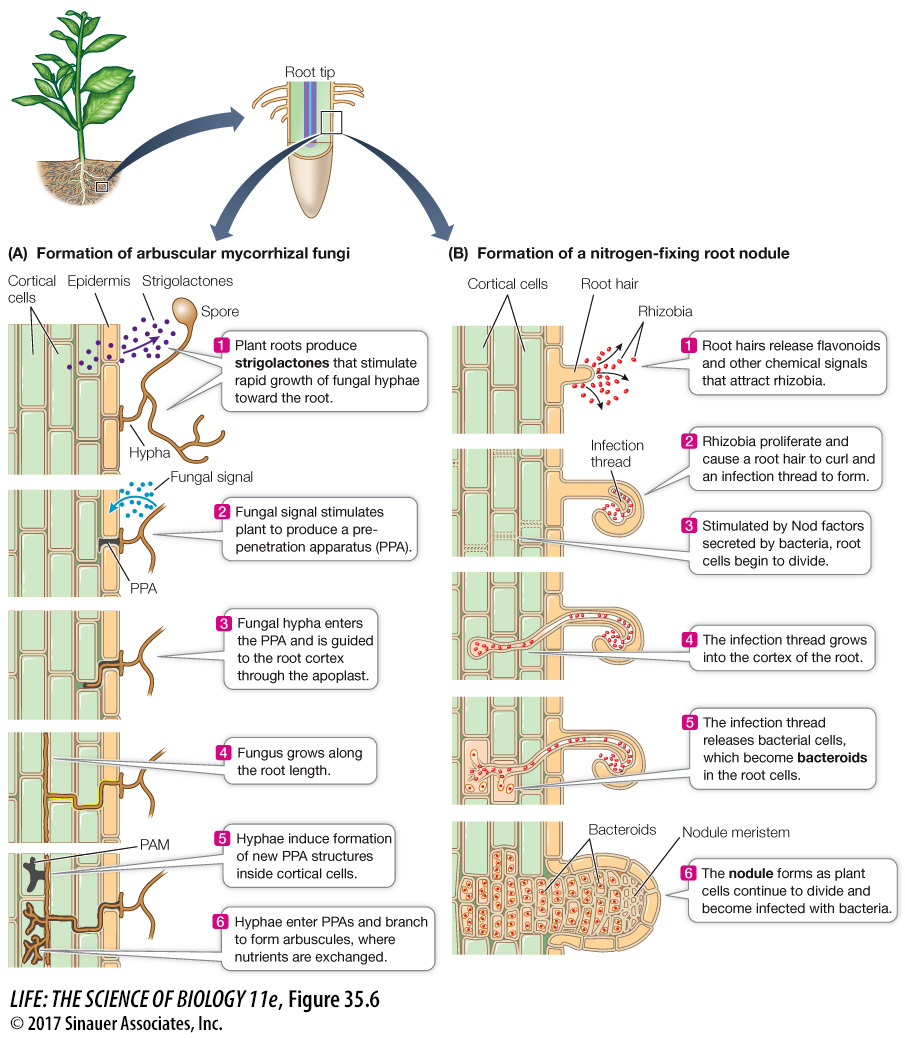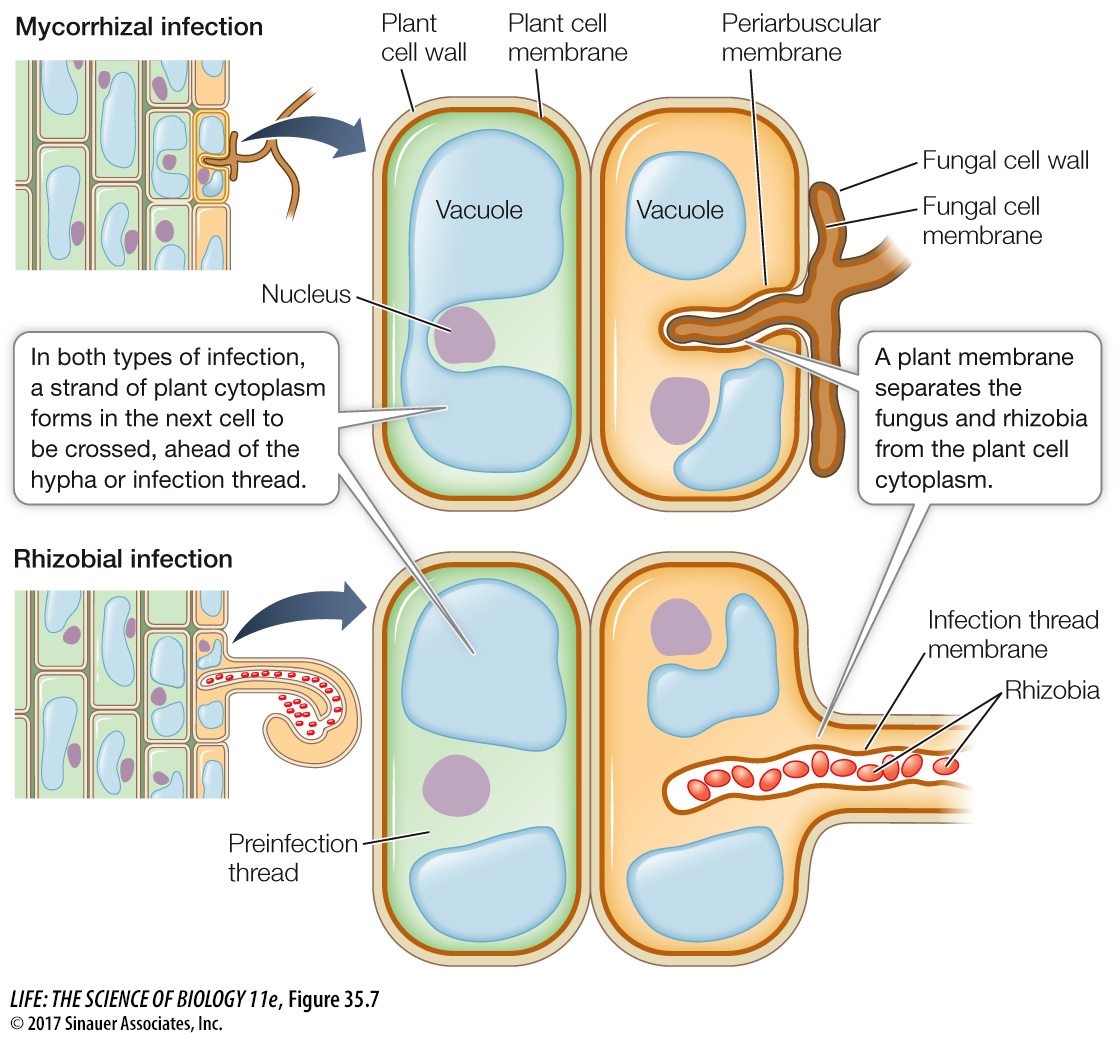Plants send signals to soil organisms
In Chapter 29 we described mycorrhizae, the association of fungi with plant roots—an interaction that occurs in more than 90 percent of terrestrial plants. Our example in Chapter 29 was ectomycorrhizal fungi, which wrap themselves around a plant root (see Figure 29.10). In this chapter we examine arbuscular mycorrhizae, in which fungal hyphae penetrate root cells. We also describe here the close association between the roots of some plants and rhizobia, a group of nitrogen-fixing bacteria (bacteria that convert atmospheric N2 into a more biologically useful form). You will see that *mycorrhizal and rhizobial associations are both initiated by signals sent by plant roots that attract the soil organisms, and that the development of these associations involves similar genes and cellular pathways.
*connect the concepts Mycorrhizal and rhizobial associations are examples of mutualism, one of the major types of interactions discussed in Key Concept 56.1.
FORMATION OF MYCORRHIZAL ASSOCIATIONS You can follow the events in the formation of arbuscular mycorrhizae in Figure 35.6A. Plant roots produce molecules called strigolactones that stimulate rapid growth of fungal hyphae toward the root. In response, the fungi produce signals that stimulate expression of genes that promote symbioses with other organisms. The products of some of these genes give rise to the prepenetration apparatus (PPA), which guides the growth of the fungal hyphae into the root cortex. The sites of nutrient exchange between fungus and plant are the arbuscules, which form within root cortical cells. Despite the intimacy of this association, the plant and fungal cytoplasms never mix—they are separated by two membranes, the fungal cell membrane and the periarbuscular membrane (PAM), which is continuous with the plant cell membrane.

Figure 35.6 Roots Send Signals for Colonization Plant roots send chemical signals to arbuscular mycorrhizal fungi (A) and nitrogen-fixing bacteria (B) to stimulate colonization. (PAM = periarbuscular membrane.)
Page 757
FORMATION OF NITROGEN-FIXING NODULES A group of plants called legumes (members of the plant family Fabaceae) can form symbioses with soil bacteria in several genera collectively known as rhizobia. The legume roots release flavonoids and other chemical signals that attract the rhizobia to the vicinity of the roots (Figure 35.6B). The flavonoids also trigger the transcription of bacterial nod genes, the products of which synthesize Nod (nodulation) factors. These and other factors, when secreted by the bacteria, cause cells in the root cortex to divide, leading to the formation of a primary nodule meristem. This meristem gives rise to the plant tissue that constitutes the root nodule. Bacteria enter the root via an infection thread, analogous to the PPA in mycorrhizal associations, and eventually reach cells inside the root nodule. There the bacteria are released into the cytoplasm of the nodule cells, enclosed in membrane vesicles similar to the PAM. Inside the vesicles, the bacteria differentiate into bacteroids—the form of the bacteria that can fix nitrogen.
Page 758
A COMMON MECHANISM Amazingly, it appears that nodule formation depends on some of the same genes and mechanisms that allow mycorrhizae to develop. For example, both processes involve folding in of the cell membrane to allow entry of the fungal hyphae or rhizobia. The similarities in the structures formed during the development of mycorrhizae and nodules are especially striking, considering that the symbioses involve members of two different kingdoms (fungi and bacteria) (Figure 35.7).

Figure 35.7 Intracellular Structures in Plant–Fungus and Plant–Rhizobium Symbioses Several steps in the development of mycorrhizae and nodules involve similar structures.

